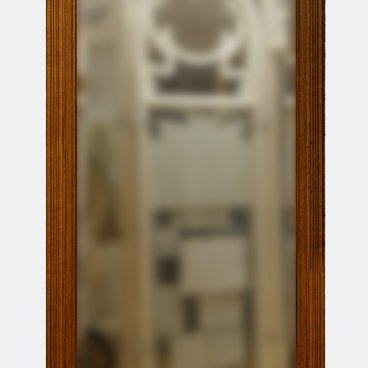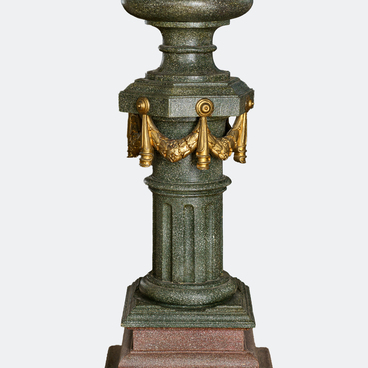The exhibition presents a keyboard musical instrument, the mechanism of which is enclosed in a wooden case, which resembles a parallelepiped with two wide sides, standing on one of the narrow edges. The case is covered with red and brown lacquer. The keyboard is mounted at the front on a narrow horizontal rectangular ledge, which is covered by a sliding lid.
The ledge on the sides has wide figured walls, which taper into thin turned posts under the keyboard. Below the keyboard on the front panel of the case there is a carved motif in the form of a square, in the center of which there is a crown surrounded by scrolls. Below, near the floor, are two wide rectangular pedals, set at an angle. The pedals are made of light metal and have a burgundy cloth covering on top. The top panel of the case has a superstructure in the form of a tall board with shaped edges, mounted vertically above the back of the case. At the top of the board’s edge there is an oval projection in the center, with an oval hole cut inside it, and an oval mirror nailed from behind. Below the board is a narrow long horizontal shelf with a shaped front edge. The shelf is flanked by vertical support boards with a figured front edge. Under the shelf in the center there is a closed compartment with a sliding lid. Part of the rear wall of the case hinges down to form a wide rectangular hatch to allow access to the mechanism. The vertical side walls of the case have wooden handles to carry the instrument.
On the back of the case there is a carved image of a shaped frame with a three-line inscription: “Warranted ten years / GEO. P. BENT / Chicago U.S.A.” To the left of the keyboard there is an inscription “Crown “in gold paint, to the right — “Organ”. Inside the first letters of both words there is an image of a crown surrounded by diverging rays. Above the keyboard there is a one-line inscription in gold paint: GEO. P. BENT Manufacturer. Chicago. ILL. U.S.A. Both pedals are inscribed Crown Organ.
The exhibit was donated to the museum in 1999. The
wooden parts were restored in 2002. The mechanism of the instrument requires
repair.

